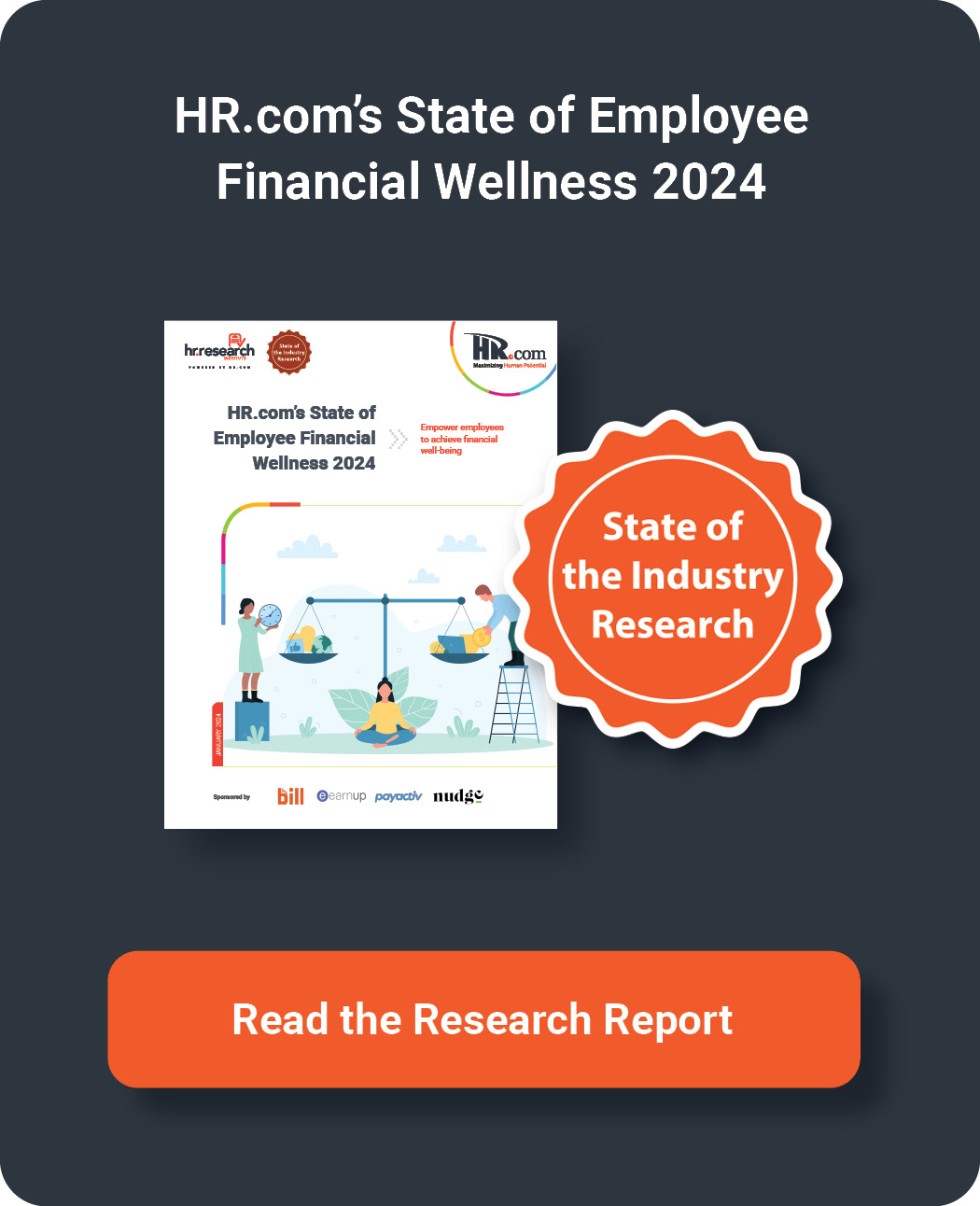HR.com’s State of Employee Financial Wellness 2024
Empower employees to achieve financial well-being
Posted on 02-28-2024, Read Time: 6 Min
Share:

A new analysis by the HR Research Institute at HR.com reveals a concerning gap between the financial struggles faced by many workers and the support provided by their employers.
Research indicates that finances are the primary source of stress for more than half (57%) of U.S. workers. However, our survey highlights that only 15% of organizations are effectively assisting employees in enhancing their financial well-being.
This report takes a deep dive into these issues. We delve into the effectiveness of various financial wellness initiatives, and we pinpoint the practices that seem most successful. To provide a better sense of the issues involved, we’ve succinctly summarized some of the key findings below.
- Organizations have a long way to go when it comes to understanding and supporting their employees’ financial needs.
- Today’s HR professionals believe employees face five major sources of financial stress: inflation issues, family/childcare expenses, not earning enough money to pay bills and pay off debt, unexpected emergency expenses and problems saving for retirement.
- Excluding their retirement plans, just 38% of organizations currently have an employee financial wellness program/initiative or are even thinking about implementing one.
- Although there are good reasons to implement financial wellness programs, many organizations also see barriers to doing so.
The Success and Prevalence of Financial Wellness Programs
Only 15% of respondents indicate that their organization is significantly successful in aiding employees in achieving greater financial wellness, while an additional 39% report moderate success. However, nearly half (46%) express that their organization's efforts in this regard are low or very low.Two-fifths of organizations have established a financial wellness program, are in the process of implementing one (31%), or are in the initial planning phases (9%). Note that we purposefully excluded “retirement programs” since these are relatively widespread (we found that 71% of responding organizations have employer retirement contributions such as 401(k) plans).

Having financial wellness programs in place seems to make a large difference in perceived success. A little over three-fifths (62%) of financial wellness leaders* currently have a financial wellness program/initiative in place or are planning to implement one, while the same is true for just over a tenth (12%) of financial wellness laggards.**
Outcomes of Financial Wellness Initiatives
Among the organizations that have adopted or intend to implement financial wellness programs, enhancing employee health (68%) and retention (66%) are the primary objectives. Retention has notably emerged as a significant focus in recent years, while improving employee health not only enhances productivity but also greatly influences the overall employee experience.Other responses chosen by at least 40% of respondents were employee engagement, helping employees make decisions free of financial stress, improving morale, and becoming an employer of choice.

Reasons Organizations Fail to Offer Financial Wellness Programs
When inquiring about why their organizations lack wellness initiatives, respondents highlighted budget constraints as the most prevalent reason, cited by 47%, followed by insufficient buy-in from senior managers (37%) and a lack of understanding about necessary resources or implementation (35%). These factors intersect and indicate a lack of prioritization. Notably, "having more important priorities" was the fourth most common reason, selected by 29%. The absence of support from senior leaders often results in inadequate resource allocation for these programs. Consequently, HR professionals may lack the motivation or time to educate themselves about financial well-being.Measuring the Success of Financial Wellness Programs
We found the most prevalent ways organizations measure the impact of their financial wellness efforts are:- enrollment/contributions to retirement plans
- employee attitudes about work
- reduction in turnover
- worker engagement
- employee satisfaction with the financial wellness programs themselves

Financial wellness leaders are more likely to measure the success of their financial well-being initiatives in every one of the twelve metrics we included in our research. Leaders are more than twice as likely to track enrollment in retirement plans (54% for leaders, only 22% for laggards). They are three times more likely to measure employees' satisfaction with their overall financial wellness programs
Specific Financial Wellness Offerings
Among organizations offering financial wellness programs, financial management or planning tools, along with financial education, were the most prevalent choices, each selected by 38% of respondents. This underscores the crucial need for financial literacy, which is frequently overlooked in public education in the U.S. despite its significance in making life-altering decisions such as managing student loans and credit.
The Secure Act 2.0
The U.S. Secure Act 2.0, which was passed by Congress in 2022, includes numerous provisions to help organizations and their employees improve retirement benefits outcomes.Despite the significance of these changes, only 25% of respondents feel very well or well-prepared to offer guidance to employees regarding the Act. In contrast, 38% admit to being only slightly or not at all prepared to provide such advice. Organizations in this category may benefit from enhancing their familiarity with this legislation in 2024.
An analysis of the disparity between the leading and lagging cohorts reveals that financial wellness leaders are nearly three times more likely than their laggard counterparts to express readiness to advise employees on the U.S. Secure 2.0 Act (32% versus 11%, respectively).
For key insights and valuable takeaways regarding successful financial wellness initiatives and practices, download the complete research report.
Notes
*Financial wellness leaders: respondents who say their organizations successfully help employees attain greater financial wellness to a high extent or very high extent.
**Financial wellness laggards: respondents who say their organizations successfully help employees attain greater financial wellness to a low extent, very low extent, or not at all.
Error: No such template "/CustomCode/topleader/category"!



